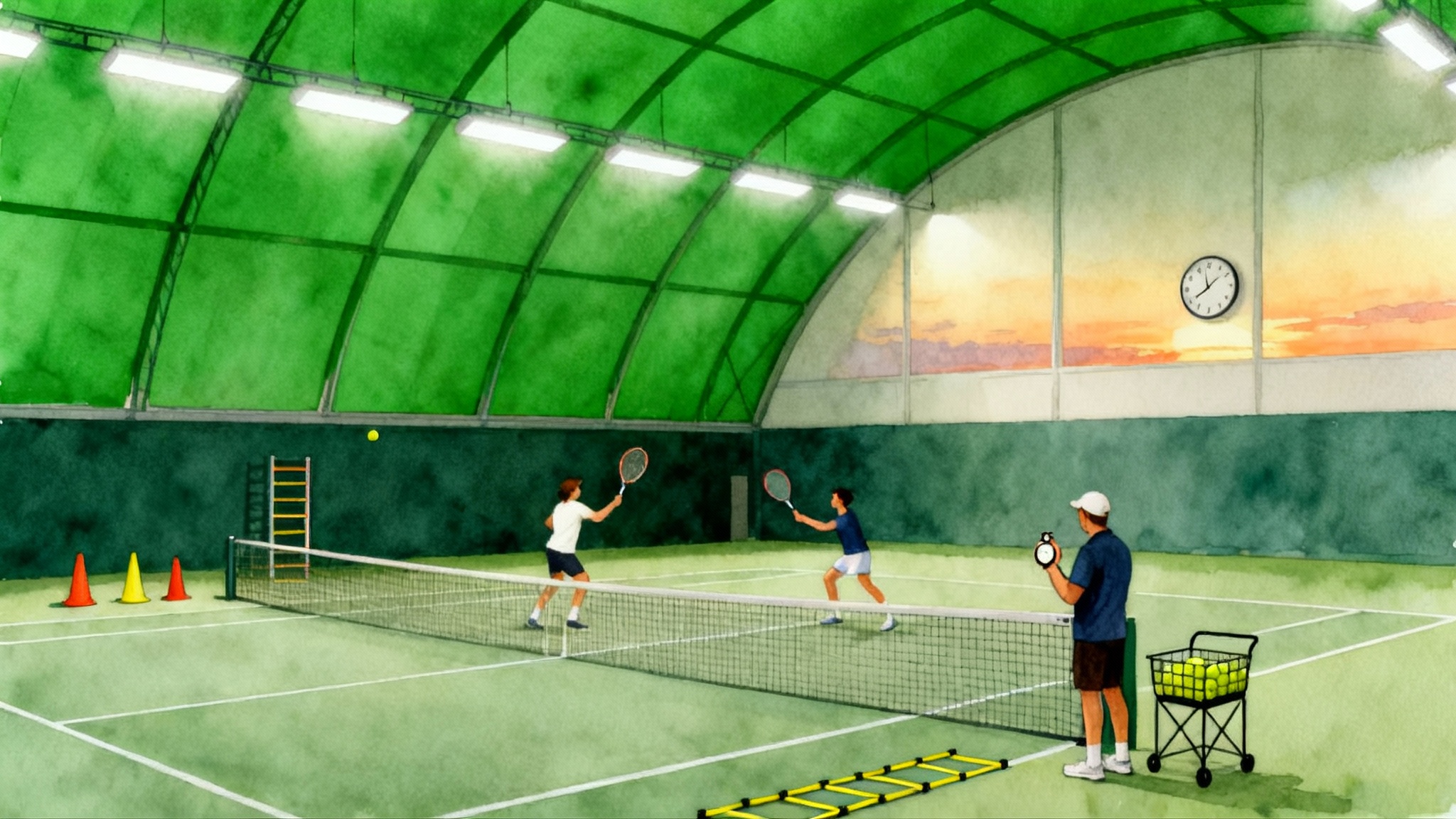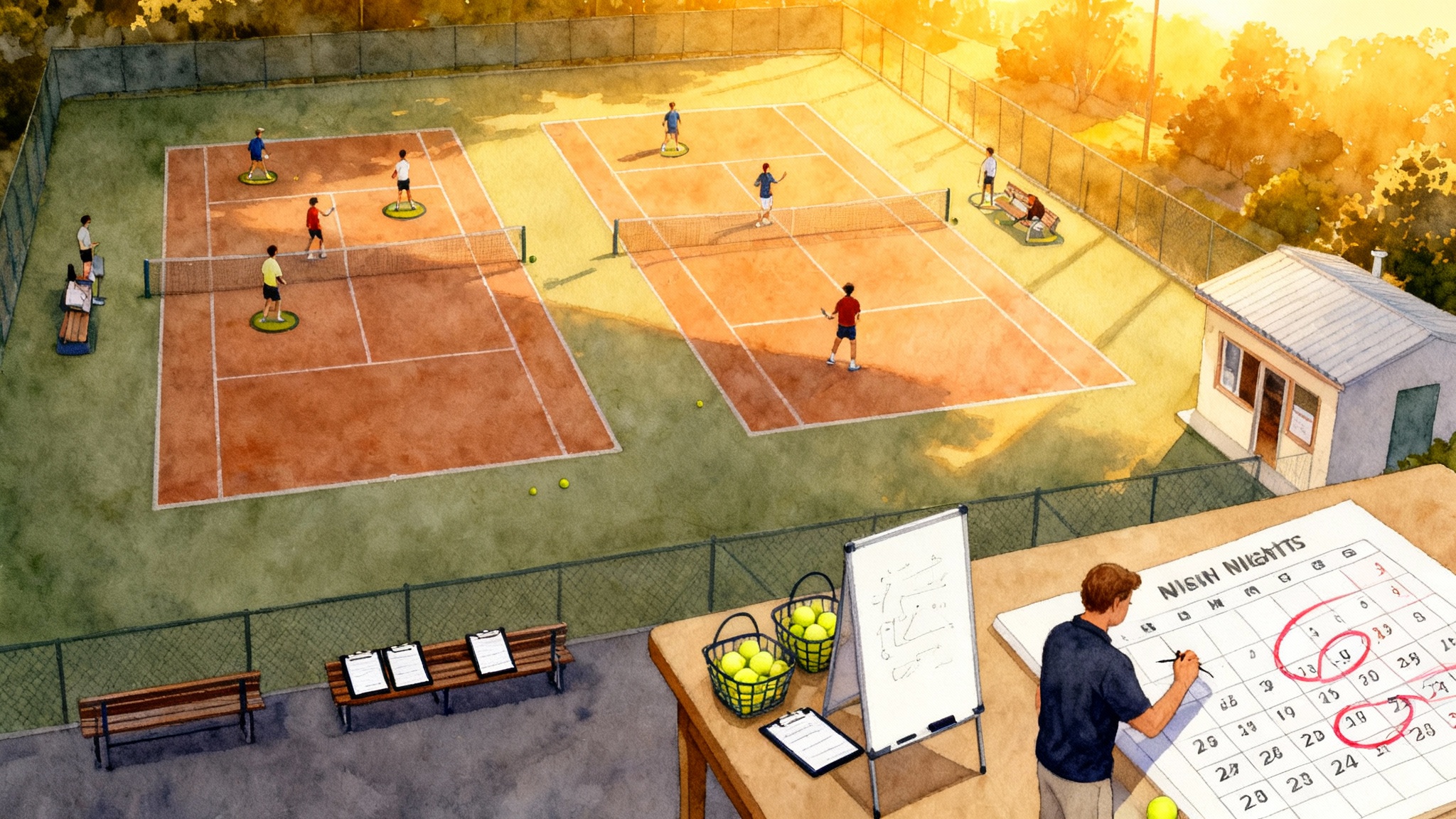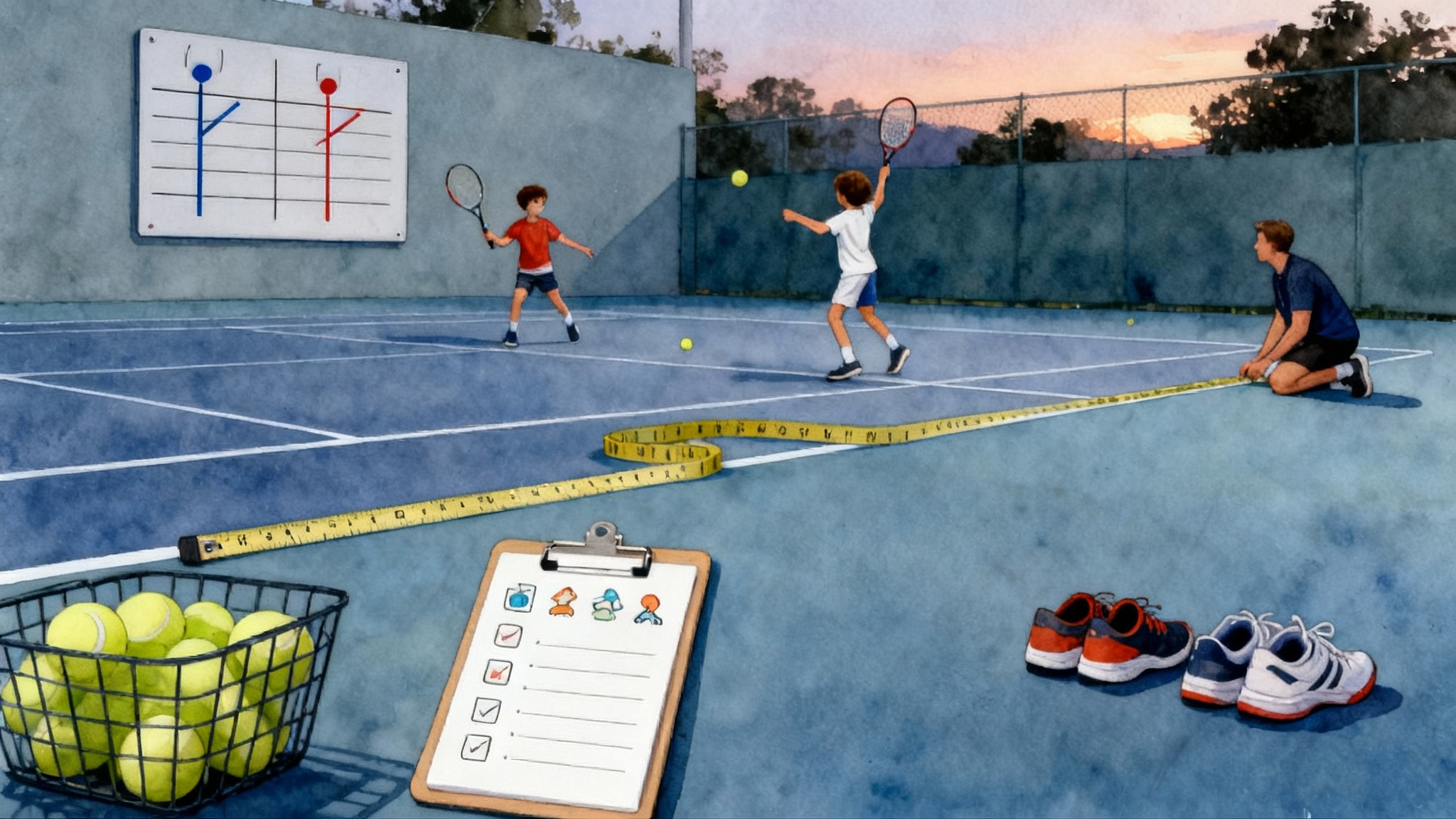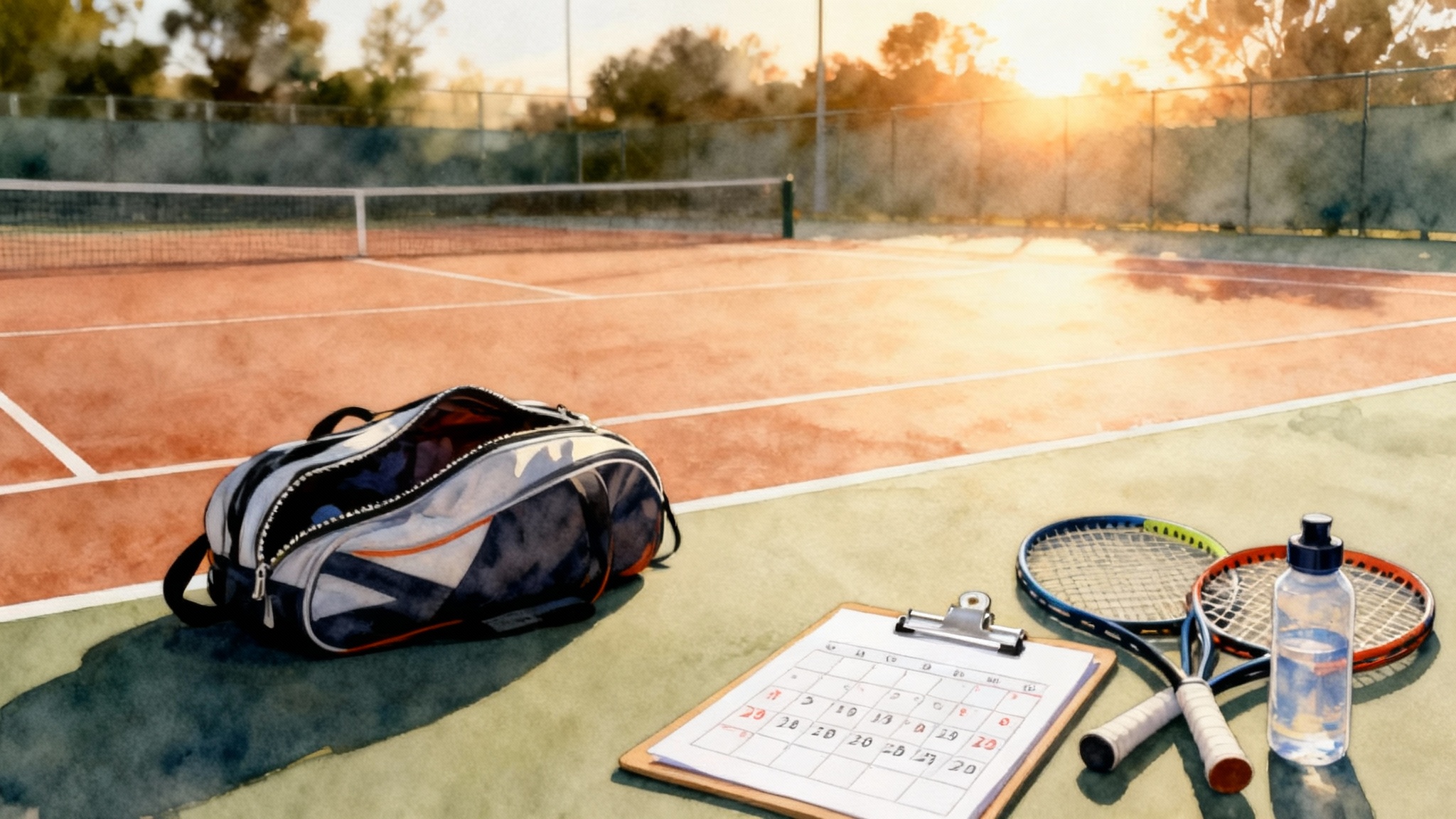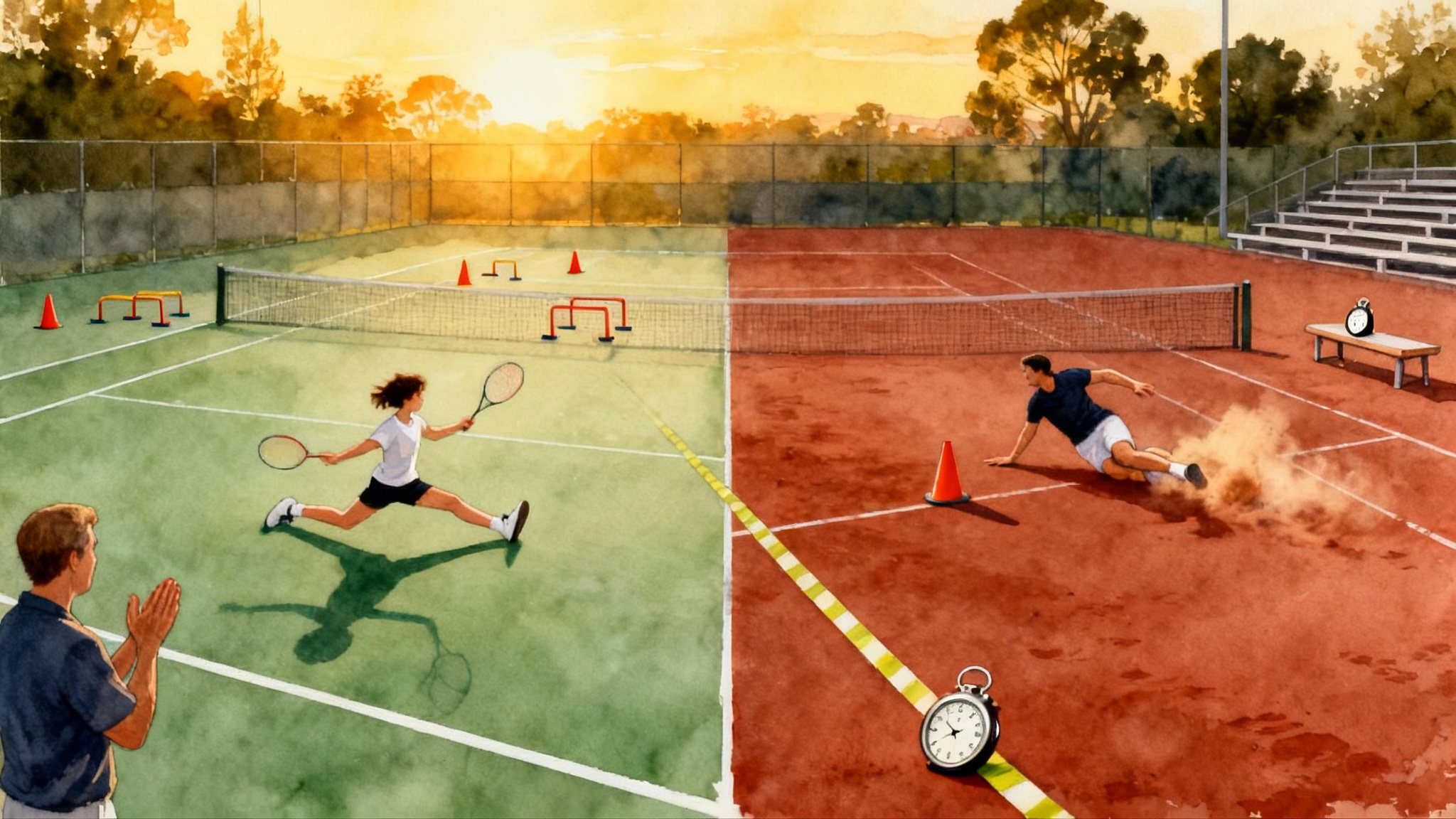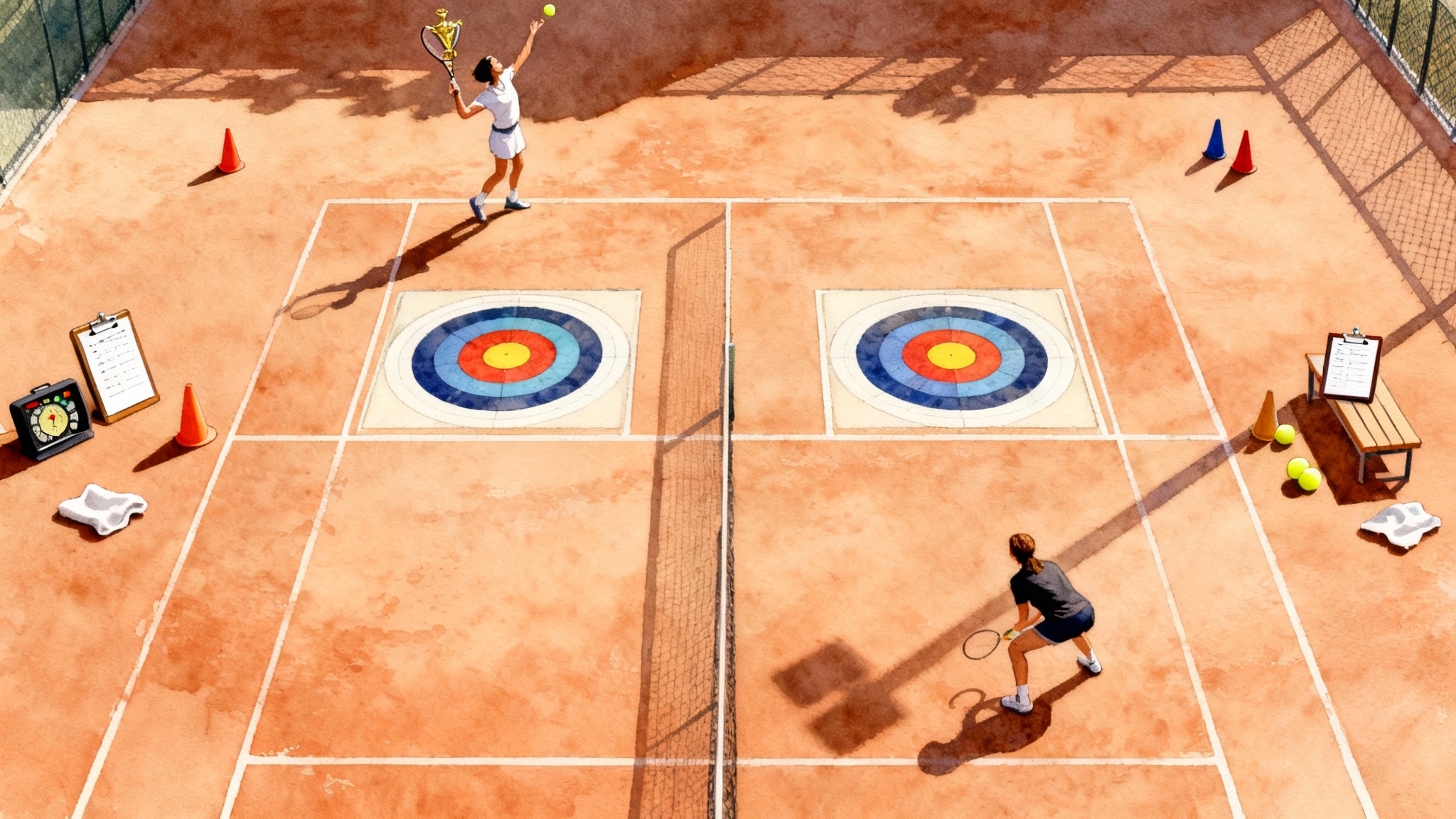ROGY to Yellow Ball in 2025: Benchmarks, Drills, and Gear
A practical, skill-based roadmap for parents and coaches to move juniors from red to orange to green to yellow. Get rally and serve benchmarks, at-home fitness screens, weekly practice templates, gear tips, and a smart match-play plan.
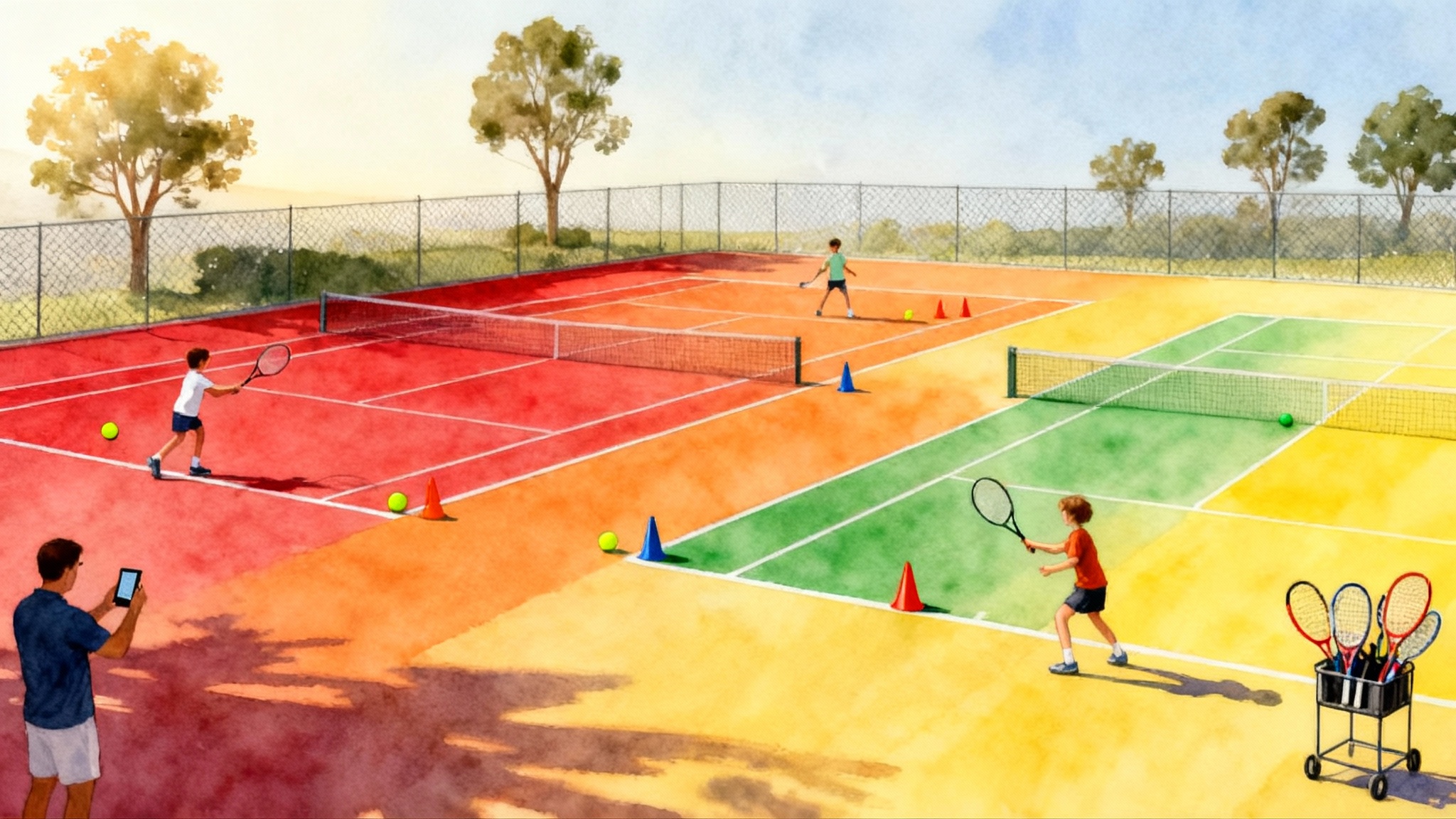
Why a skill-based pathway beats guesswork
Parents and coaches want to help kids love tennis, progress safely, and avoid the injury and burnout that come from jumping levels too fast. A clear, skill-based pathway does exactly that. ROGY stands for Red, Orange, Green, Yellow. These are the stages that scale down court size, ball speed, and racquet length so players learn clean swing shapes, rally skills, and movement before graduating to the next challenge. Think of ROGY like a set of adjustable training wheels that gradually come off as balance and control improve.
This guide gives you precise benchmarks for when to move up, simple at-home screens to check readiness, weekly practice templates by stage, racquet and string sizing that protect young arms, sample drills for each color court, and a smart approach to match play that keeps development first. For plug-and-play scheduling, see our weekly training blueprints for 2025.
The progression at a glance
- Red ball: 36-foot court, lowest compression ball, shorter racquet, short swings. Goal is fun, contact in front, and rhythmic rallies close to the net.
- Orange ball: 60-foot court, moderate bounce, slightly longer racquet. Goal is baseline rallying, directional control, and an emerging overhead serve.
- Green ball: Full court with a slower ball. Goal is rally tolerance from the baseline, patterns, and second-serve reliability.
- Yellow ball: Standard ball on the full court. Goal is consolidating technique under speed and spin, adding weapons without losing consistency.
The move from one color to the next should be earned by skill, not age or peer pressure. Use the benchmarks below as your green lights.
Red to Orange: readiness benchmarks and practice model
Red ball is about building rhythm and confidence. Players start close to the net so the ball arrives slowly and at a manageable height. Move to orange when most of the following are true.
Readiness benchmarks
- Rally tolerance: 5 to 7-ball cooperative rally with a coach or parent on a red court from service-line distance. Contact is in front, and the player keeps bounce-hit rhythm without chasing.
- Serve targets: 6 of 10 underhand serves land diagonally in a marked box. If an overhead motion is introduced, 4 of 10 overhead serves land in the target with a simple throwing motion and balanced finish.
- Footwork checks: Visible split step before each opponent contact, side-shuffles without crossing feet, and a two-step recover to a simple center mark after each shot.
- Contact point checks: 80 percent of forehands struck between waist and chest height with the racquet moving from low to high. Backhand contact not jammed against the body. Finishes are balanced for three seconds.
At-home fitness screens
- Balance: Single-leg stand, eyes open, 20 seconds each side without hopping.
- Throwing pattern: Ten overhand throws to a wall from 10 feet using a light foam ball, catching cleanly at least 7 of 10.
- Jump rope rhythm: 30 seconds of continuous single jumps without tripping more than twice.
- Core control: Front plank, 20 seconds with level hips and quiet breathing.
Weekly practice template for red
- Frequency: Two to three sessions per week, 60 minutes each.
- Warm-up, 10 minutes: Animal walks, skipping, side shuffles, and shadow swings.
- Skill block 1, 15 minutes: Hand feeds at the net for clean contact and finish holds.
- Skill block 2, 15 minutes: Cooperative net rallies with a parent or coach, then step back two feet and repeat.
- Serve and return, 10 minutes: Underhand serve targets; return to the middle with a split step.
- Game play, 10 minutes: Simple service-line games to 7 points.
Sample red-court drills
- Drop and hit alley: Player self-drops and hits into a taped 6-foot-wide alley, counting clean contacts in a row.
- Red ladder: Coach alternates soft forehand and backhand feeds. Player must split, set, hit, and freeze for a three-count after each shot.
- Serve bowling: Place two cones in the red service box. Player rolls or softly toss-serves to knock them down.
Racquet and string guide for red
- Racquet length: 19 to 23 inches for most players under 4 feet 2 inches tall.
- Grip check: With the racquet standing on the ground next to the player, the butt cap should be near mid-hip, not reaching the ribs.
- Strings: Pre-strung synthetic gut is fine. Keep tension soft from the factory. Avoid polyester entirely at this stage.
Match play at red
- Use festival formats, team relays, and short toss-serve games. Scoring to 7 or timed rounds keeps energy high. Do not chase ratings. The only goal is rally time, smiles, and learning basic rules like where to stand and when to call the score.
Orange to Green: readiness benchmarks and practice model
Orange ball expands the court and asks for direction control from the baseline. Before moving to green, check these boxes.
Readiness benchmarks
- Rally tolerance: 8 to 10-ball cooperative crosscourt rally from the orange baseline on both forehand and backhand. Two successful down-the-line changes inside a rally of 8.
- Serve targets: 6 of 10 serves land in the correct box from the orange baseline using a throwing-based motion. At least 3 of 10 aimed to a cone near the T or wide corner. A basic second serve with higher arc lands 5 of 10.
- Footwork checks: Split step on every opponent contact, crossover recovery after wide shots, and a clean drop step to defend deeper balls. Player can demonstrate both neutral and open stances on forehand.
- Contact point checks: Forehand contact 12 to 18 inches in front of the lead hip. Backhand contact out in front with a stable head and level shoulders.
At-home fitness screens for orange
- Hop and stick: Five single-leg forward hops, soft landings without the knee collapsing inward on at least 4 of 5 per side.
- Lateral shuffle test: Five shuffles right and back, then left and back, maintaining a low base and stable head. Total time under 20 seconds for a simple 5-5-5 shuttle at a safe, age-appropriate distance.
- Med ball chest pass: From a seated position, pass a 1 kilogram ball to a partner or wall. Eight feet or more shows adequate upper body rhythm for the serve.
- Plank plus reach: 20-second plank while tapping each shoulder five times without hip sway.
Weekly practice template for orange
- Frequency: Three sessions per week, 75 minutes each.
- Warm-up, 10 minutes: Jump rope, carioca, and quick shadow footwork patterns.
- Skill block 1, 20 minutes: Crosscourt live-ball rallies to a cone target. Add one change of direction per rally after 10 minutes.
- Skill block 2, 15 minutes: Approach and volley from short feeds, then from a short ball off a rally.
- Serve and return, 15 minutes: Serve to T and wide cones. Returns focus on split step and two-step recovery to center.
- Games, 15 minutes: First-to-4 games with orange scoring, no long breaks.
Sample orange-court drills
- Traffic light targets: Green cone deep crosscourt, yellow mid court, red short angle. Player must hit the called color.
- X pattern: Four-ball sequence crosscourt, crosscourt, change line, recover. Count completed sequences.
- Serve ladder: Hit one serve down the T, next serve wide, repeat. Add a penalty of a shadow serve if two misses occur in a row.
Racquet and string guide for orange
- Racquet length: 23 to 25 inches, usually right for 4 feet 2 inches to 4 feet 8 inches height.
- Grip size: Enough space for a pencil-width gap between fingertips and palm on the forehand grip. Avoid oversized grips that block wrist mobility.
- Strings: Synthetic gut or multifilament at moderate tension. Keep it comfortable. Avoid full polyester.
Match play at orange
- Add team matches and short-set formats to 4 games with a tiebreak at 3-3. Emphasize serve routines, return position, and honest line calls. Still avoid chasing ratings or traveling heavily. One local event per month is plenty if your player is smiling at practice and recovering well.
Green to Yellow: readiness benchmarks and practice model
Green dot is a bridge to the yellow ball. The court is full size, so spacing and recovery matter more than ever. Move to yellow when these skills are present most days.
Readiness benchmarks
- Rally tolerance: 12-ball cooperative rally from baseline crosscourt on both sides at a medium pace. Ability to add a planned change of direction on ball 5 or later and keep the rally alive.
- Direction and depth: 6 of 10 balls land past the service line when aiming deep crosscourt. Player can hit three in a row to a 6-foot-wide alley target on both wings.
- Serve reliability: 6 of 10 first serves in with purposeful pace and shape, plus 5 of 10 second serves in with clear spin or higher arc. No more than two double faults in a 4-game set.
- Return quality: Split step timing consistent, with 7 of 10 returns in play against a similar-level server.
- Footwork and spacing: Clean crossover recovery after being pulled wide, with the first recovery step happening within 0.5 seconds of contact. Player finds contact in front on 80 percent of forehands and 70 percent of backhands from full court.
At-home fitness screens for green
- Plank standard: 45 to 60 seconds with steady breathing and flat hips.
- Single-leg squat to chair: Five controlled reps per side to a knee angle near 90 degrees without knee valgus.
- Standing broad jump: Distance equal to or greater than body height indicates adequate lower body power for the full court.
- Overhead throw: Ten throws with a light ball reaching 15 yards for coordination and trunk sequencing.
Weekly practice template for green
- Frequency: Three to four sessions per week, 90 minutes each.
- Warm-up, 12 minutes: Dynamic mobility, jump rope, split step timing drills.
- Skill block 1, 25 minutes: Crosscourt live-ball with depth targets. Add change-of-direction patterns after 10 minutes.
- Skill block 2, 20 minutes: Approach patterns and simple transition volleys. Emphasize split step, first volley height, and recovery.
- Serve and return, 18 minutes: Two first-serve locations each side, then second-serve shape work. Pair with return depth goals.
- Competitive sets, 15 minutes: Short sets to 4 games using no-ad scoring. Between sets, review one technical cue and one tactical cue.
Sample full-court drills for green
- Three lanes depth: Tape three depth lanes. Player must keep 6 of 10 balls in the back two lanes at moderate speed.
- 2 cross 1 line: Hit two crosscourt balls then change down the line on a coach call, recover to center, and repeat.
- Serve plus one: Serve to a called target, then play the next ball to the open court. Keep a simple chart of serve locations and rally outcomes.
Racquet and string guide for green
- Racquet length: 25 to 26 inches for most players between 4 feet 8 inches and 5 feet 2 inches. Stronger or taller players can try 27 inches late in green if they swing smoothly.
- Swing weight feel: Player should be able to shadow swing 10 forehands in a row without the racquet lagging behind the hand. If the racquet droops, it is too heavy.
- Strings and tension: Synthetic gut or multifilament remains the safest, usually 45 to 52 pounds. Avoid full polyester unless a coach confirms heavy, fast swings and no elbow or shoulder discomfort. A hybrid with multifilament mains can be a middle step if needed.
Match play at green
- Introduce more formal set play but stay local and development focused. One to two matches per week is plenty. Keep a simple stat like second serves in play or crosscourt depth instead of obsessing over wins. Delay serious rating goals until yellow skills stabilize.
Yellow ball: consolidate, then specialize
Reaching yellow ball is not the finish line. It is the start of consolidating technique under a faster, higher-bouncing ball. The temptation is to chase pace. The priority should be contact quality, height, and corner depth.
Benchmarks to thrive at yellow
- Rally goals: 8 to 12-ball crosscourt rallies at coach-defined tempo, with the ability to elevate height over the net to neutralize. Players can alternate heavy crosscourt and a single down-the-line change without breaking balance.
- Serve goals: Two purposeful first-serve locations per side and a second serve that survives pressure. Track double faults per set and aim for two or fewer.
- Pattern goals: One forehand pattern and one backhand pattern a player trusts on big points, such as serve wide and play to the open court, or neutral rally then change line when the opponent’s ball lands short.
Yellow weekly template
- Frequency: Four sessions per week, 90 to 120 minutes each. Two are development focused, one is competition focused, and one is fitness plus recovery.
- Development days: Technique reps, spin windows, and target combos. Use our home video analysis guide to capture clips and check contact height and spacing.
- Competition day: One or two sets with clear process goals. Review between sets, then a short constraint game like crosscourt only, or backhand plus approach.
- Fitness and recovery: Movement quality, light strength, jump rope or agility ladder, then mobility. Sleep and hydration plans are part of the program.
Yellow gear guardrails
- Racquet: 26 to 27 inches depending on height, strength, and swing speed. Many 11 to 13 year olds still do well with 26 inches while they gain strength.
- Strings: If polyester is introduced, consider a hybrid with multifilament mains to protect the arm. String on the softer side and cut it out when it goes dead. Comfort first.
How to add match play without chasing ratings
Ratings do not measure joy, work ethic, or long-term ceiling. Use them later as one tool, not the compass. For a practical view of competition planning, including when ratings help and when they distract, see how to use UTR and WTN for planning.
A sensible match progression
- Red: Festival stations and timed games. Rotate partners and courts. Teach ball pickup, score calling, and a handshake.
- Orange: Short sets to 4 games, no-ad scoring. Play two sets against different opponents in the same session. Parents watch quietly from one spot, applauding effort and sportsmanship only.
- Green: Regular sets with a tiebreak at 6-6. Use a one-page checklist of process goals, such as split step timing and depth past the service line.
- Yellow: Organized league play and occasional tournaments when practice looks better than matches, not the other way around. Pick events within a short drive to protect school, sleep, and budget. Track one or two stats that matter to development, like first-serve percentage and rally length won.
A practical test before adding more tournaments
- The player asks to practice more after a loss rather than blame conditions.
- They can finish a two-hour practice and still show good footwork in the last 15 minutes.
- They accept coaching between points without emotional spikes or slumps.
What a quality academy evaluation looks like
A professional assessment should feel like a friendly lab. You and your player should leave with data, video, and a plan. Look for these elements.
- Intake and goals: Short conversation that captures sport history, growth spurts, injury notes, and goals for the next three months.
- Movement screen: Balance, single-leg squat, plank quality, and a few agility steps. The goal is safety and individualized footwork cues.
- Technical capture: Slow-motion video of forehand, backhand, serve, and volleys. Coach gives one root-cause priority per stroke, not a list of ten tips.
- Ball-tracking targets: Simple depth and direction games with cones or chalked lanes to quantify control. A coach who uses targets teaches intention.
- Serve map: A few minutes of target serving to learn current locations and spin. Second-serve reliability is noted separately.
- Practice plan: A written, week-by-week plan with session length, themes, and the drills your player will see. Clear benchmarks for the next color level if applicable.
- Communication habits: How often you will get updates, what progress looks like, and how to contact the coach if school or schedule changes.
Red flags during evaluations
- Endless talking and little hitting.
- A one-size-fits-all lesson where every player runs the same drill regardless of level.
- Pushing a heavier racquet or polyester string before movement and contact are stable.
- Immediate push to travel or chase ratings without discussing skill benchmarks.
Quick reference: move-up checklist by color
Use this compact checklist to confirm moves. Aim to check most boxes on most days before you level up.
Red to orange
- 5 to 7-ball rallies near the net
- 6 of 10 serves land in a target box
- Split step, side shuffle, and recover after each ball
- Balanced finishes on both sides
Orange to green
- 8 to 10-ball crosscourt rallies from the orange baseline
- 6 of 10 serves in, with at least three to a called location
- Confident crossover recovery and drop step on deeper balls
- Forehand and backhand contacts clearly in front
Green to yellow
- 12-ball rally tolerance at medium pace from full baseline
- 6 of 10 first serves and 5 of 10 second serves in
- Depth past the service line on most neutral balls
- Return of serve in play 7 of 10 against similar level
Putting it all together
- Use benchmarks, not birthdays, for level changes.
- Keep at-home screens short and consistent so you can spot growth.
- Practice templates keep sessions balanced. Do a little technique, a little rally work, and a little serve and return every week.
- Choose racquets and strings that protect the arm and match swing speed. Comfort and control beat hype.
- Add match play in stages and resist the rating race. Your player’s skills and joy will compound when practice leads the way.
When you are ready for a friendly, professional check of your player’s current color and next steps, book a short on-court visit with us. We will run the movement screen, capture video of the core strokes, and hand you a simple plan for the next six weeks. It is free, and spots go quickly. You can reserve a time in a minute at our site with this book a free on-court assessment.
Final word
Tennis development thrives on the right challenge at the right time. The ROGY pathway gives you the dials to set that challenge with precision. Use the checklists, keep sessions playful and purposeful, and let skills, not the calendar, set the pace. If you want a second set of eyes, we are ready to help your player take the next confident step.
